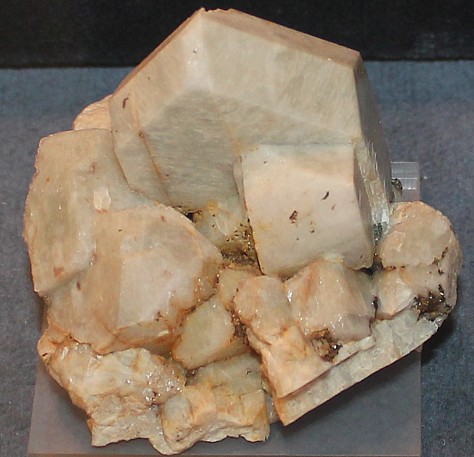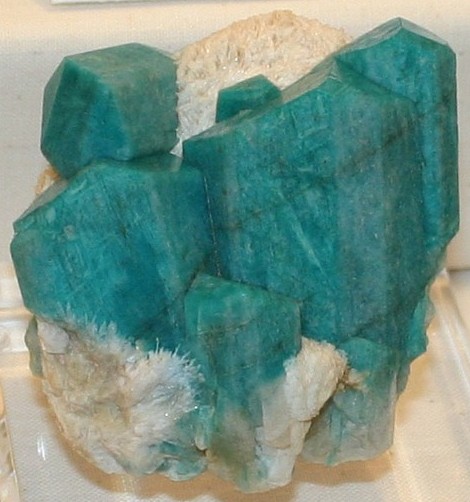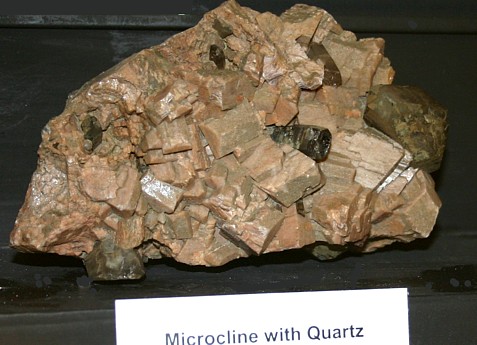|
.
Microcline Mineral Facts:
Chemical Formula: KAlSi3O8
A silicate of aluminum and
potassium, the formula for microcline is the
same as orthoclase, Silica 64.7%, alumina 18.4%, potash 16.9%. A Potash
Feldspar or K-spar.
Colors:
white to pale yellow.
Also blue-green in Amazonite or rarely red.
The amazonite variety of microcline,
exhibits a fine pleochroism.
Hardness:
6 to 6.5
Density: 2.54
to 2.57
Cleavage:
The usual
feldspar cleavage; perfect parallel to
the basal plane, slightly less perfect parallel to brachypinacoid..
Crystallography: Triclinic
Axial lengths and angles for microcline are
only slightly different from those of orthoclase. Ordinarily the
crystals of the two species cannot be told apart except by very accurate
measurements or a microscopic examination. Microcline crystals are
usually twinned according to the same laws as orthoclase. Also
microscopically twinned according to the albite and pericline laws,
characteristic of the triclinic feldspars. A thin section of microcline
under the microscope in polarized light usually shows a characteristic
grating structure, caused by the crossing at nearly right angles of the
twin lamellae formed according to these triclinic twinning laws.
Orthoclase, being monoclinic, could not show such twinning..
Luster:.
Vitreous to pearly
luster. It is transparent to opaque.
|

Microcline Feldspar close up |
|
Composition,
Structure and Associated Minerals:
Microcline occurs in acid igneous rocks, especially granites.
It occurs in rock slices as small shapeless grains and plates. Like
orthoclase in ordinary light, but between crossed nicols shows the
characteristic ''crosshatched" appearance due to the repeated wedge-shaped
twins on two laws. Microcline weathers fairly readily to muscovite, kaolin
and quartz. The name Microcline is derived from two Greek words meaning
little and inclined, referring to the slight variation of the cleavage angle
from 90.
Identification and Diagnostics
Before the blowpipe it is difficultly fusible at 5. Microcline is
insoluble in acids. When mixed with powdered gypsum and heated on platinum
wire gives the violet flame of potassium. Usually to be recognized by its
color, hardness and cleavage. Distinguished from the other feldspars by its
right-angle cleavage and the lack of striations on the best cleavage
surface. Microcline is distinguished from orthoclase by the presence
of striations on basal plane, due to twinning. The two species only to be
distinguished from each other by careful examination.
Occurrence,
Localities and Origins:
Microcline occurrences are the same
as for orthoclase. Much of the feldspar that is identified as orthoclase in
reality is microcline. Feldspar of the orthoclase and microcline varieties
(both are potash feldspar) is extremely abundant in the pegmatite veins
associated with many granitic intrusions. These pegmatites usually consist
of a mixture of quartz and feldspar, and in some places potash feldspar is
the dominant constituent. In some localities mica of commercial value is
found in the veins and the feldspar is then obtained as a by-product of mica
mining. Most of the feldspar of commerce is used in pottery manufacture. The
rock known as "Cornish stone" is an altered granite and consists essentially
of partly kaolinized potash feldspar. It is used largely in the English
pottery trade. Orthoclase and microcline contain from 10 to 15 per cent, of
potash, and for that reason rocks rich in potash feldspar, notably those of
the syenite type, are sometimes used in a crushed condition as fertilizers.
Potash feldspar has been obtained chiefly from the pegmatites of the United
States, Canada, Norway and Sweden, and Italy. A large part of the potash
feldspar found in granite-pegmatites is of the microcline variety.
Microcline crystals are well
developed at Striegau, Silesia; in the pegmatite dikes of southern Norway;
and with a green color in the Ural Mts. and at Pike's Peak, Colorado, and is
known as amazonite or Amazon stone.
Amazonite is the bright-green variety of microcline.
Fine Amazonite crystal specimens are much prized by collectors. At times it
is also polished and used as an ornamental material. Microcline is readily
distinguished from the other feldspars by the crosshatched appearance of
basal cleavage fragments between crossed nicols, due to compound twinning.
The amazonstone variety, moreover, shows a strong pleochroism, the color
varying from a fairly deep green to pale green or almost colorless. Fine
specimens have been obtained at Pike's Peak, Colorado, and the state of
Nevada near Hawthorne in the U.S.A., where they occur at both locations in a
coarse-grained granite or pegmatite. Another notable occurrence is near
Amelia, Virginia, again in coarse-grained granite. Fine specimens have also
been obtained near Miask, in the Urals, and in Madagascar.
Return to the
Mineral Collectors Information Page
|

Microcline Feldspar, Amazonite Variety |
|



